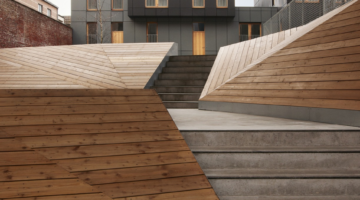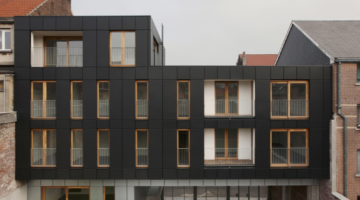


Le Lorrain, Molenbeek-St-Jean, Belgium
Main objectives of the project
The renovation of the former Brumétal scrap metal dealership by MDW Architecture in Brussels transformed it into a social housing complex featuring a four-flat building and three maisonettes. Using industrial materials to honor its past, the project opens up the plot, creating a wide communal space and promoting a sense of community. The design includes various housing types arranged around a central courtyard, with private gardens and recessed entrances. Elevated maisonettes and strategic layout changes maximize light exposure, blending contemporary architecture with the site's industrial heritage.
Date
- 2011: Construction
Stakeholders
- Architect: MDW
Location
Country/Region: Belgium, Brussels
Description
This project involves renovating the former Brumétal scrap metal dealership into a social housing complex, consisting of a four-flat building connected by a large communal open space to three maisonettes at the rear. Belgian practice MDW Architecture has transformed the site in Brussels using industrial materials that reference its past. The project, part of the "Maritime" district contract, opens up the previously built-up plot, allowing the street to "breathe" through a wide opening. This contemporary architectural and urban intervention aims to rejuvenate the neighborhood while preserving its industrial heritage.
The design reflects a modern approach, considering both the spirit of the place and program requirements. It includes various housing typologies: simplex, duplex, and triplex units ranging from two to four bedrooms, organized into one apartment building and three terrace houses at the rear. The focus is on architectural and environmental quality. Homes are arranged around a central courtyard with communal meeting and play areas. Each house also features a private garden and a recessed entrance to create a buffer between the front door and public space.
Given the site's enclosure by high party walls, the interior was cleared, and the maisonettes were elevated to maximize light exposure and sunlight access. These decisions also facilitated the inclusion of a garage at street level and minimized the need for extensive site depollution. On the street front, the apartments were raised and set back, creating a visual sequence between the road and the complex. Lowering the eastern party wall reduced the oppressive feeling of the interior and allowed more light to penetrate the plot.
The social housing project offers a top-tier design and a disruptive architecture setting, while maintaining the landscape and history of the plot and the sense of community.

